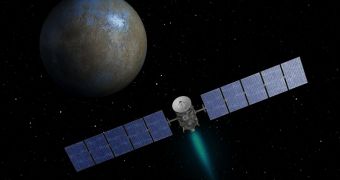Dawn mission managers at the NASA Jet Propulsion Laboratory (JPL), in Pasadena, California, say that they are currently working on establishing the schedule for the visit that the spacecraft will conduct around the dwarf planet Ceres, in the Inner Asteroid Belt (IAB).
The IAB is located beyond the orbit of Mars, but ahead that of Saturn, and contains countless space rocks of various sizes. It is also home to the largest asteroid/protoplanet in the solar system, Vesta, which was Dawn's scientific target before setting sail for Ceres.
Dawn spent more than a year around Vesta, from July 2011 to September 2012. It achieved orbital insertion around the asteroid on July 16, 2011, at around 04:47 UTC, and occupied four different science orbits during its stay there.
The spacecraft departed Vesta on September 5, 2012, embarking on a long flight that will eventually take it to Ceres in early February 2015. End of operations is currently scheduled to occur in July 2015.
Before Dawn reaches its destination, JPL experts need to make sure that they have a reliable checklist and flight plan available for the mission. This is very important because this spacecraft is the first-ever to attempt to enter orbit around a dwarf planet.
Experts say that it will also become the first satellite to orbit two distinct bodies in the solar system. “Our flight plan around Ceres will be choreographed to be very similar to the strategy that we successfully used around Vesta,” JPL Dawn project manager Bob Mase explains.
“This approach will build on that and enable scientists to make direct comparisons between these two giants of the asteroid belt,” he goes on to say. The JPL group is currently scheduled to start conducting Dawn approach-related operations as early as late January, 2015.
After it is captured by Ceres' gravitational pull, the satellite will occupy a series of orbits around the protoplanet, from 13,500 kilometers (8,400 miles) to 4,430 kilometers (2,750 miles). The lower orbit is very important if Dawn is to image the ice fields believed to cover the surface of the dwarf planet.
By November 2015, Dawn will fly as low as 375 kilometers (233 miles) above Ceres' surface. This low altitude will allow its visible and infrared mapping spectrometer (VIR) instrument to produce global maps of its ice distribution patterns.
“We are expecting changes when we get to Ceres and, fortunately, we built a very capable spacecraft and developed flexible plans to accommodate the unknowns. There's great excitement in the unexpected – that's part of the thrill of exploration,” explains the director and chief engineer of the Dawn mission, JPL expert Marc Rayman.

 14 DAY TRIAL //
14 DAY TRIAL //